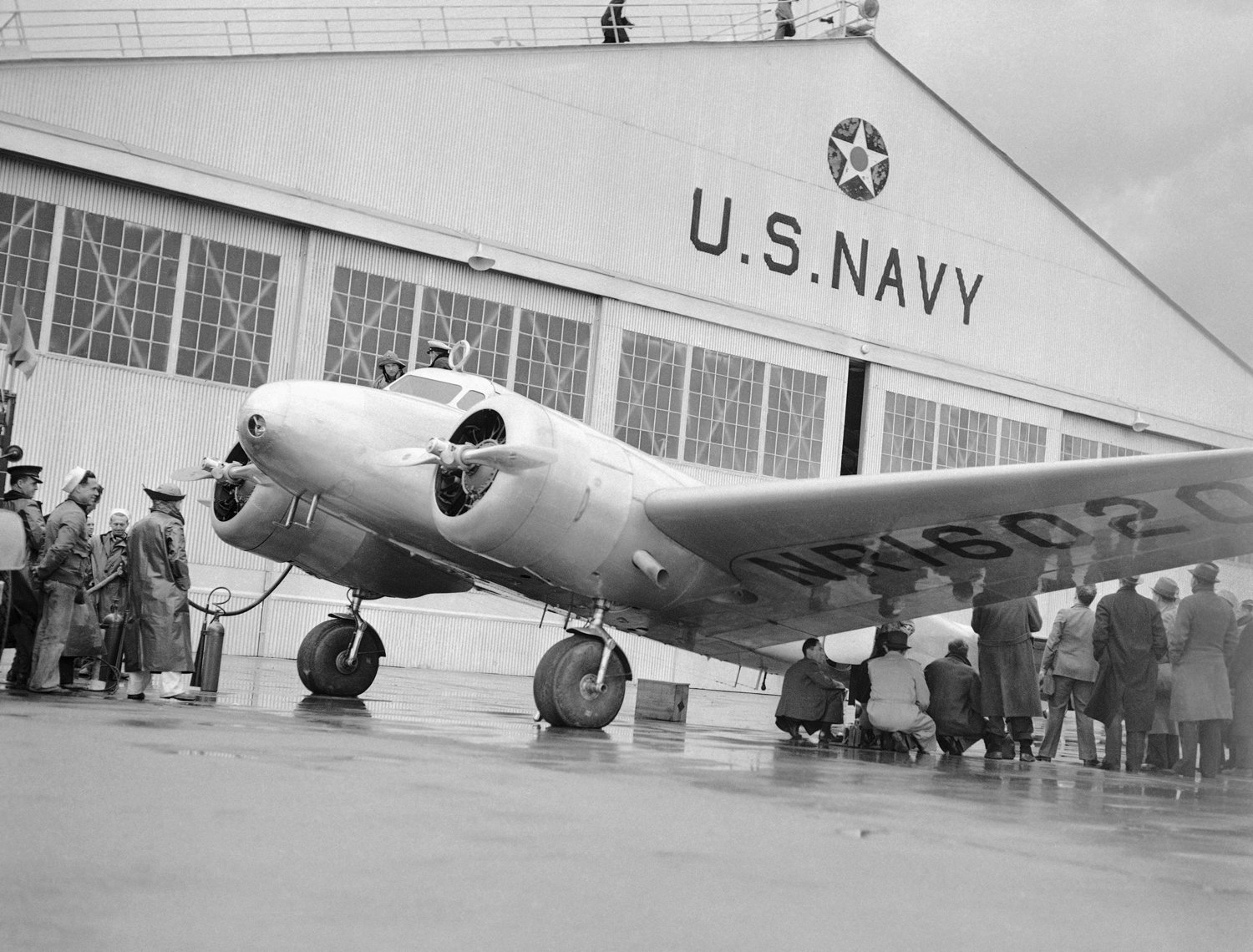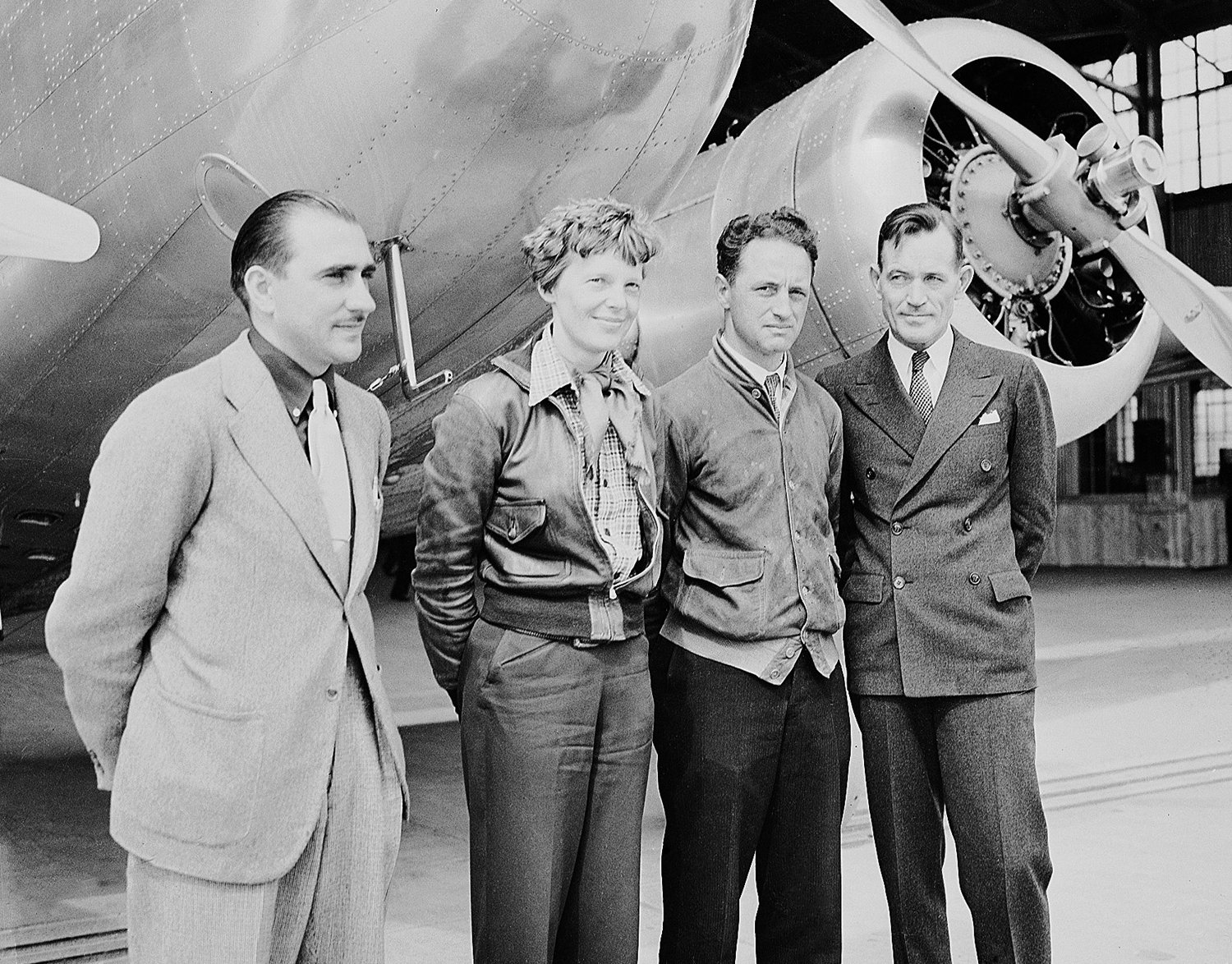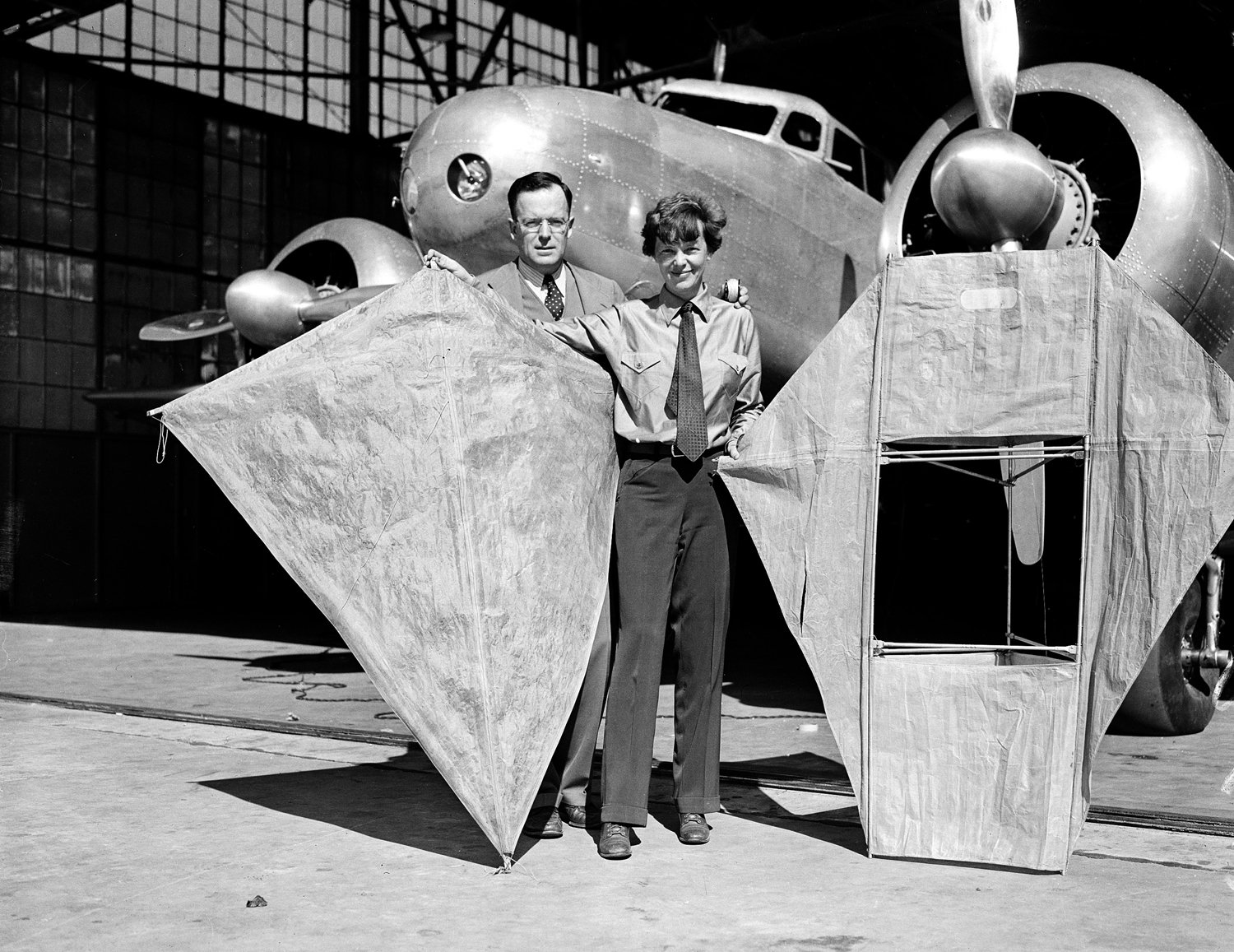85 years since the disappearance of Amelia Earhart

Aviation pioneer Amelia Earhart was born in 1897 and began her career as a nurse and social worker. In her spare time she flew. In 1928, the New York publisher George Palmer Putnam, whom she later married, asked if she wanted to be the first woman to fly the Atlantic. In 1932 she flew the Atlantic solo, winning the Distinguished Service Cross from the U.S government. Three years later she completed flights from Mexico City to New York, and from Hawaii to California. In 1937, she began her most ambitious flight, an attempt to circumnavigate the earth on a route close to the equator.
Amelia Earhart achieved her fame by overcoming the prejudice against women pilots. “Manufacturers refuse us planes,” she said, listing some of the obstacles facing women; “the public have no confidence in our ability. If we had access to the equipment and training men have, we could certainly do as well. Thank heaven, we continue willingly fighting a losing battle….but if enough of us keep trying, we’ll get someplace.”
American aviatrix Amelia Earhart poses with flowers as she arrives in Southampton, England, after her transatlantic flight on the "Friendship" from Burry Port, Wales, on June 26, 1928. The tri-motor "Friendship" was piloted by two men as Earhart kept the flight log, making her the first woman passenger to fly across the Atlantic. (AP Photo)
American aircraft pilot Amelia Earhart is assisted by her husband, George Palmer Putnam, as she climbs out of the cockpit of her autogiro after completing a transcontinental flight to the West Coast and back, at the Metropolitan Airport in Newark, N.J., on June 22, 1931. (AP Photo)
A crowd cheers for aviatrix Amelia Earhart as she boards her single-engine Lockheed Vega airplane in Londonderry, Northern Ireland, for the trip back to London on May 22, 1932. Earhart became the first woman to fly solo nonstop across the Atlantic when she finished her 2,026 mile journey on May 21, 1932 in under 15 hours after departing from Harbour Grace, Newfoundland. (AP Photo)
Noted aviatrix Amelia Earhart, is shown standing beside the red and gold monoplane which she brought down to become the first woman to ever complete a solo flight across the Atlantic, May 21, 1932, Londonderry, Northern Ireland. (AP Photo)
Capt. J. A. Mollison and Amy Johnson celebrated their first wedding anniversary with George Palmer Putnam and Amelia Earhart at the Putnam home at Rye, New York, July 29, 1933. The four are in the garden left to right are George P. Putnam, Amy Johnson, Amelia Earhart and Capt. Mollison. (AP Photo)
Amelia Earhart to Kent Cooper, June 28, 1932, Kent Cooper Papers, Associated Press Corporate Archives.
As the first woman to be honored with the award, Amelia Earhart receives the Distinguished Flying Cross from U.S. Vice President Charles Curtis, left, in Los Angeles, Calif., on July 29, 1931. Governor James Rolph of California is on the right. (AP Photo)
Amelia Earhart receives the National Geographic Medal by U.S. President Herbert Hoover, in honor of her transatlantic flight, on June 21, 1932, at the White House lawn in Washington, D.C. Standing on the left is Dr. Gilbert Grosvenor, President of the National Geographic Society, on the right is first lady Lou Henry Hoover watching the scene. (AP Photo)
Amelia Earhart, left, and Capt. Harry Manning, her navigator, check instruments in the plane she’ll use on a round the world flight, March 6, 1937, Los Angeles, Calif. Capt. Manning will accompany her across the Pacific to Australia. (AP Photo)




Amelia Earhart, left, and navigator Fred Noonan pose with a map of the Pacific showing the route of their last flight in this undated photo. (AP Photo)
American aviatrix Amelia Earhart, right, and her husband, George Putnam, talk over plans for Earhart's second attempt to fly around the world. They are in a hangar where Earhart's plane Electra is being prepared for flight in Miami, Fla., May 29, 1937. (AP Photo)
The following excerpt is from an AP article by Richard Pyle, dated March 31, 2007.
New clues in 70-year-old Earhart mystery
It's the coldest of cold cases, and yet 70 years after Amelia Earhart disappeared, clues are still turning up.
Long-dismissed notes of a shortwave distress call beginning, "This is Amelia Earhart..."
The previously unknown diary of an Associated Press reporter, surfacing after decades.
And a team that has already found aircraft parts and a woman's shoe on a remote South Pacific atoll, hoping to return this year to find more evidence, perhaps even DNA.
If what's known now had been conveyed to searchers then, might Earhart and her navigator have been rescued? It's one of a thousand questions that keep the case from being declared dead, as Earhart herself was a year and a half after she vanished.
George Palmer Putnam talks on the telephone with the White House asking for aid in the search effort for his missing wife, Amelia Earhart, in Oakland, Ca., on July 2, 1937. Navy commander V.H. Ragsdale, Naval reserve, Oakland airport, stands by. Earhart disappeared during her flight over the Pacific. (AP Photo)
For nearly 18 hours, Earhart's twin-engine Lockheed Electra drummed steadily eastward over the Pacific, and as sunrise etched a molten strip of light along the horizon, navigator Fred J. Noonan marked the time and calculated the remaining distance to Howland Island.
It was July 2, 1937, and the pair were near the end of a 2,550-mile trek from Lae, New Guinea, the longest leg of a "World Flight" begun 44 days earlier in Oakland, Calif.
At the journey's end there a few days hence, Earhart would become the first female pilot to circumnavigate the globe.
Noonan, a former Pan American Airways navigator, estimated when the plane would reach an imaginary "line of position" running northwest-southeast through Howland, where they were to rest and refuel for the onward flight to Hawaii.
"200 miles out," Earhart radioed, her "whispery drawl" heard by the Coast Guard cutter Itasca waiting off Howland.
Overnight, Itasca's radio operators had become increasingly exasperated with Earhart, who hadn't acknowledged Itasca's messages or its Morse code homing signal. They decided the glamorous "Lady Lindy" was either arrogant or incompetent.
What nobody knew not Earhart, and not Itasca was that her plane's radio-reception antenna had been ripped away during takeoff from Lae's bumpy dirt runway. The Itasca could hear Earhart, but she was unable to hear anything, voice or code.
Also listening aboard the Itasca was James W. Carey. The 23-year-old University of Hawaii student had been hired by The Associated Press to cover Earhart's Howland stopover.
He also had been keeping a diary.
The diary was unknown to Earhart scholars until last September, when a typewritten copy was bought on eBay by a member of The International Group for Historic Aircraft Recovery, or TIGHAR. The non-profit organization rejects the official verdict that the fliers were lost at sea, believing instead that they may have crash-landed on an uninhabited atoll called Gardner Island, in the Phoenix Islands 350 miles south of Howland, and lived for a time as castaways.
"Even though the diary doesn't answer the big question, it's an incredible discovery," said TIGHAR executive director Ric Gillespie, who has led eight expeditions to the island since 1989, and plans another one this July if his group can raise enough money.
The diary, he said, presents "a firsthand witness about what went on during those desperate hours and days."
On July 1, word came that Earhart was finally airborne from Lae.
Early on July 2, Carey wrote in his diary: "Up all last night following radio reports scanty ... heard voice for first time 2:48 a.m. `sky overcast.' All I heard. At 6:15 am reported `200 miles out.'"
If Noonan's dead-reckoning did not bring the plane directly over Howland, Earhart would fly up and down the 337-157 degree "line of position" until she found it.
"To the north, the first landfall is Siberia," says Gillespie, "so if they didn't find it soon, they'd have turned back south, knowing that even if they missed Howland, there were other islands beyond it Baker, McKean and Gardner on that same line."
But by now, Earhart would be into her five-hour fuel reserve, and even in daylight, islands could be obscured by billowy clouds and their shadows on the water.
At 7:42 a.m., Earhart's voice suddenly came loud and clear: "KHAQQ to Itasca. We must be on you but cannot see you. But gas is running low. Been unable to reach you by radio. We are flying at 1,000 feet."
A welcoming committee from Itasca was "waiting restlessly" at the airstrip, Carey wrote. Binoculars scanned the blue.
At 8:55 a.m., Earhart was back on, sounding distraught: "We are on line of position 157 dash 337... we are now running north and south."
Then the radio went silent.
Believing that Earhart must be out of gas, Itasca's captain, Cmdr. Warner K. Thompson, had already ordered the welcoming committee back to the ship. "Flash news from ship Itasca: `Amelia down,'" Carey had written in his diary.
But with all frequencies reserved for possible distress calls, Carey's news reports would have to wait. AP broke the "Earhart missing" story from Honolulu, quoting Coast Guard officials there.
Meanwhile, Carey filled the diary: "Itasca set off `full speed ahead' to search the northwest quadrant off Howland."
Nothing was sighted, and by evening the ship's mood, Carey wrote, had "taken a turn to the more serious side."
George Palmer Putnam, husband of famed aviator Amelia Earhart, is shown at a Coast Guard radio station with maps and charts to follow his wife's plane on her attempt to round the world, in San Francisco, Calif., on July 3, 1937. Earhart's plane is hours overdue while en route between New Guinea and Howland Island in the Pacific Ocean. (AP Photo)
While Navy ships rushed to the rescue of Amelia Earhart and her navigator, Fred Noonan, Noonan's wife Mary Beatrice spent long hours at the radio, July 4, 1937, hoping for word from the missing airship, lost somewhere in the South Pacific. (AP Photo)
Seventy years later, the Earhart mystery lingers.
In more than 50 nonfiction books and even a movie, writers embraced theories ranging from a crash at sea to abduction by aliens, from Earhart executed by the Japanese as a spy to living under another name in New Jersey.
Two books "Amelia Earhart's Shoes," written by four TIGHAR volunteers, and Gillespie's "Finding Amelia" offer the thesis that Earhart and Noonan crash-landed on a reef on Gardner Island, and survived, perhaps for months, on scant food and rainwater.
Anxiously awaiting return of their mates, George Palmer Putnam, husband of Amelia Earhart, and Mrs. Frederick J. Noonan, wife of Miss Earhart’s navigator, look over latest reports on the missing pair in Oakland, California on July 3, 1937. Miss Earhart’s plane is believed down near Howland Island, a tiny sand spit in the Pacific. Reports of receipt of SOS calls from the ship were the latest developments. (AP Photo)
Paul Mantz, technical adviser of Amelia Earhart, kept in close touch by telephone with all reports from the search area around Howland Island for the lost round-the-world plane of the noted Aviatrix in Los Angeles July 6, 1937. Mantz, who declares Miss Earhart would be unable to send distress signals should her plane have come down in the water, later flew to San Francisco to confer with George Palmer Putnam, Miss Earhart’s husband. (AP Photo)
Expeditions to the island, now called Nikumaroro, have compiled tantalizing evidence.
In 1940, a British overseer on Gardner recovered a partial human skeleton, a woman's shoe and an empty sextant box at what apparently was a former campsite. The items were sent to Fiji, where a doctor decided the bones belonged to a stocky European or mixed-blood male, ruling out any Earhart-Noonan connection.
The bones later vanished, but in 1998, TIGHAR investigators located the doctor's notes in London.
Using a modern computer database, Dr. Karen Ramey Burns, a forensic osteologist at the University of Georgia, found the Fiji doctor's measurements were more "consistent with" a female of northern European descent, about Earhart's age and height. Burns' report was independently confirmed by another forensic expert.
On visits to the island, TIGHAR teams found an aluminum panel, possibly from an Electra; another woman's shoe and "Cat's Paw" heel, dating from the 1930s; a man's shoe heel, crude tools and an oddly cut piece of clear Plexiglas.
The sextant box might have been Noonan's. The woman's shoe and heel resemble Earhart's footwear in a pre-takeoff photo. The plastic shard is the exact thickness and curvature of an Electra window.
Still, the evidence remains circumstantial, Gillespie says. "We don't have serial numbers."
As news of the missing aviators flashed around the world, the Navy ordered six warships into the hunt.
Although radio calls from the Electra along with later "distress calls" picked up by shortwave listeners were triangulated by Pan American's Pacific stations to the Phoenix Islands, officials ignored a New Zealand cruiser 48 hours from there and instead sent the battleship USS Colorado southward. By the time it reached the area four days later, the radio calls had ceased.
Colorado's senior float-plane pilot, Lt. John O. Lambrecht reported "signs of recent habitation were clearly visible" at Gardner Island. But no people were sighted, and "it was finally taken for granted that none were there."
Accounts of shortwave radio calls were also shrugged off.
In Rock Springs, Wyo., Dana Randolph, 16, heard a voice say, "This is Amelia Earhart. Ship is on a reef south of the equator." Aware that "harmonic" frequencies in mid-ocean often could be heard far inland, experts said the shortwave transmission was probably genuine.
In St. Petersburg, Fla., 15-year-old Betty Klenck heard a woman identify herself as Earhart, followed by pleas for help and agitated conversation with a man who, the girl thought, sounded irrational.
Having heard Earhart's voice in movie newsreels, Betty was sure it was her and still is.
"I remembered it every night of my life," Betty Klenck Brown, now 84 and widowed, said in a telephone interview from her home in California.
The man, she recalls, "seemed coherent at times, then would go out of his head. He said his head hurt ... She was trying mainly to keep him from getting out of the plane, telling him to come back to his seat, because she couldn't leave the radio...."
Betty took notes in a school notebook as the shortwave signals faded in and out. They ended when the fliers "were leaving the plane, because the water was knee-deep on her side," she said.
Her father notified the Coast Guard but was brushed off.
George Spindler, left, and Arthur Monsees, California amateur radio operators, try to establish contact with Amelia Earhart, July 13, 1937. The boys claimed to have received a signal, as yet unverified. (AP Photo/GM)
Last September, TIGHAR volunteer Arthur Rypinski paid $26 for an Earhart document offered on eBay. It turned out to be a copy of Carey's diary.
Carey's son, Tim Carey of Woodbridge, Va., says his father died in 1988. His role as an AP reporter on the Earhart story was part of family history. "The diary was completely in character for him," the son adds. "He was a real note-keeper."
George Palmer Putnam paused at the airport long enough to tell reporters of his $2,000 reward offered for information of his missing wife, Amelia Earhart, or her plane, down somewhere in the Pacific Ocean in New York on July 29, 1937 . The money is directed particularly at Japanese fishermen. Mr. Putnam was flown from Los Angeles. (AP Photo)
Now raising funds for a ninth TIGHAR expedition to Nikumaroro in July, Gillespie says the Carey diary serves as a reminder to always "expect the unexpected" in the Earhart case.
"Pacific islanders don't wear shoes, so we know there was one foreign castaway, and maybe two, a man and a woman, on Gardner ... We hope this summer to recover human remains for DNA testing and find aircraft pieces that could be conclusively identified as from Amelia's plane.
"This is the expedition that could at last solve the mystery. I think we are right on the edge of knowing for a certainty what happened."
Amelia Earhart checks the fuel mechanisms inside her plane in Newark, NJ on Feb. 14, 1937. (AP Photo)
Text excerpts from The Last Flight of Amelia Earhart in 20th Century America and AP story New clues in 70-year-old Earhart mystery by Richard Pyle, dated March 31, 2007.
Text and photo editing by Kathryn Bubien
See these photos on AP Images
